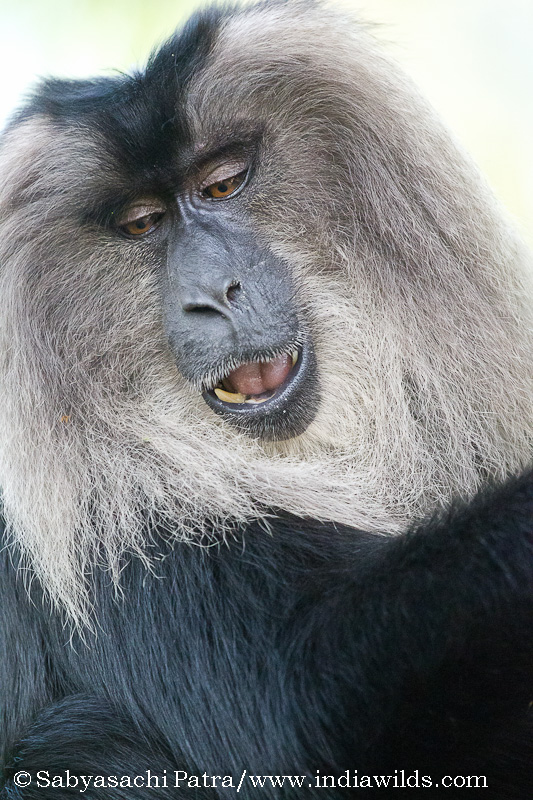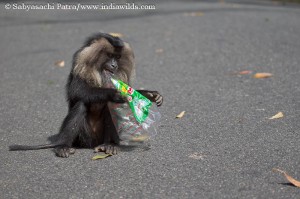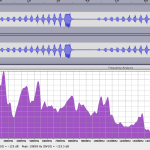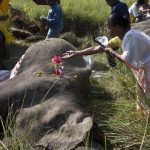A Call in the Rainforest
The Western Ghats due to its rich biodiversity had caught my imagination since a long time. And I had been intrigued by the Lion-tailed macaques, not because they are endangered, but because of their similarity with our mythical Jambavan from Ramayana.
Though Jambavan in Ramayana is supposed to be a Bear, as a kid I used to wonder how bear and monkeys can be friends and when I first learnt about Lion-tailed Macaques I immediately thought that friendship among this species could be more probable than between that of a bear and monkeys. Your imaginations certainly run riot when you are a kid. As a kid, you don’t have any qualms of imagining things which are contrary to established beliefs and facts. Even today, I certainly don’t have the capability to reinterpret the Epic Ramayana.
The childhood fascination for the Lion-tailed Macaques remained dormant as we hardly find anything about Lion-tailed Macaques in popular literatures. Later on during my growing up phase, I was intrigued by the mating process of Lion-tailed Macaques. Unlike others, they need a series of mountings before ejaculation happens.
In the meanwhile, the countless shikar stories and jungle lore dished out by Jim Corbett, Kenneth Anderson, Gadadhar Ray and others, helped in my developing fascination towards the tiger, which turned into reverence. I have spent countless hours waiting for the tiger in waterholes or in trekking or in jeep safaris. Never did I think that I will be making a film on Lion-tailed Macaques.
With the disruptive technology in the form of HD filming capability built into a DSLR, I started filming to raise conservation issues. As a wildlife photographer and a conservationist, I still yearn for those pristine wilderness areas. Unfortunately, today not many areas can be described by the word primordial wilderness. Either, one finds the ubiquitous cellphone towers or signals, electric wires, houses or when one sits down to record the sound of chirping birds one finds the sound of some local songs wafting across and bombarding your ears. So in the past, I had ignored photographing animals in the road or close to human habitations or atleast where there are tell tale signs of humans.
When I look down memory lane, going more than a decade back when I had first visited the Western Ghats, the wilderness areas were comparatively in a much better state. Today, shocked by the devastation wrought by the human hand, I can no longer remain a passive spectator. I was moved by the plight of the group of lion-tailed macaques that live close to Valparai in the Anamalais. I have realised that this story is happening again and again in all the places. The only difference here is that the protagonists are different, as the animals impacted by the explosive and unrestrained expansion of our human habitations are different. However, the issues remain similar. This drove me to conceptualise, film and produce the movie “A Call in the Rainforest” to view the impact of our actions through the eyes of the protagonist – the lion-tailed macaque.
This film ‘A Call in the Rainforest‘ is a Call for Action. I hope you all will like the preview.
Cheers,
Sabyasachi
Edit: This film “A Call in the Rainforest” was honoured as the Official Selection in Wildlife Conservation Film Festival New York in 2014.
- GoPro Hero 12 Black - 6 September,2023
- Leopards: The Last Stand - 2 July,2023
- Drifting in the Waters of Sundarbans - 26 March,2023














Kudos, Sabyasachi.. this teaser only makes the appetite to watch the entire film stronger. Proud of this and proud to be your friend… It needs such passion to save our very own rain forests. Stunning photography as always. But then thats you.
All the best always.
Hi Sabyasachi, I have been following your wild life pics, they are very informative and I love the way you describe them.
I am very curious to see the whole film after seeing the trailer of the film (on Lion Tailed Macaque) Beautiful narration and photography.
Good luck to you and hope you acheive the impact you are looking for on the release of your film.
Best wishes, thanks for the great insight into the unknown world of the deep jungles…:)
Chitrita,
I am happy that you liked the preview. We have become city dwellers and don’t realise how fast our increasingly consumptive behaviour is leading to destruction of rainforests and other wilderness areas.
Hi Sujata,
I am happy to know that you have been following my wildlife documentation. I have been writing newsletter everymonth and mailing it to about 10,000 people. However, I felt that there is a need for a audio-visual medium like films to create greater impact. I plan to do screenings in major cities as well as go for a video release later.
Cheers,
Sabyasachi
Congratulations on your maiden venture! Truly a moving story. I would be interested to watch the full length. Apt subject for today’s man animal conflict episodes. Wishing you all the best.
Sabyasachi ji….
Excellent work…. the Preview gives a very good feel of the Western Ghats, I am anxious to watch the full movie… the Cinematography with 1D mark IV has come out very well. Felt as though watching some Hollywood movie trailor or like Discovery, Natgeo shots.. Wish you all the very best for its release….
Hi Sabyasachi
This film preview is really awesome and inspirational..Will get to know and learn many things out of this film..waiting to watch d complete movie..had recently been to rain forest in wayanad..it was disturbing to see mostly all hills covered by tea plantations..the forest is rapidly disappearing… These Macaques cannot live in plantations and their habitat is completely destroyed which has ultimately put them in endangered bracket. Really respect your efforts trying to create awareness and save the wildlife..anxiously waiting for d movie.
Hi Sabyasachi Da,
Congratzzzzz……Greatz Trailer.
Its really like Hollywood trailer….wow…waiting for full movie.
That’s great stuff Sabyasachi. I have been waiting to see if something like this would be forthcoming from Indiawilds. Happy indeed that it has. The short teaser has brought back many many memories of travel/movement in these jungles with my father an old time DFO in the old Madras Province.
Keenly awaiting the publishing of the full video.
Regards
Thanks Chandrashekran ji,
I am happy that this could bring back some fond memories for you. I will inform you when we have a screening. I am planning to hold screenings in various towns to raise awareness.
Wonderful preview , Great Job,
I am eagerly waiting to see the full movie.
All the best for your work!!!!
Dear Sabyasachi,
An stunning piece of work to portray the deteriorating issues of Western Ghats. I think not many has come forward to do something like this.
I can understand the trouble you underwent to get eyelevel footage of LTM & GIH. I’m sure it has been paid off and just can’t wait to see the full film.
With kind regards,
Dileep
Beautiful photography and wonderful editing! You are a creative and skilled videographer, Sabyasachi.
Stephen,
Thanks for your compliments. I am happy that you liked it.
Hi;
Beautiful photography& excellent editing! Your creativity is very much appreciable.
Keep it up!
With all the Best wishes!
Prakash Surve
Nice teaser Sabyasachi. Sharp photography. As always !! Really thought, it was one of those short trailers for Discovery or NatGeo Channnels !! 😉
Am so glad, you are taking up this cause on twin issues on rain forests � saving the rain forests & another victim of the devastation, the lion-tailed macaque. When, young, I have travelled & trekked in these forest areas & was always in awe, of the pristine beauty & lovely sounds emanating out of these forests. The rain forests in western Ghats are more diverse than those of our counterparts in Assam & northeast, with apparently more than 4000 plant species occurring in this relatively small area of hill land combining Karnataka, Kerala & Tamilnadu. Unfortunately, they are getting depleted at a rather alarming rate. The destruction of the forests has been exceptionally rapid during the last 50 years, thanks to the increase in human population, negligence & ignorance on part of the state authorities & communities that reside within the forest areas & poorly controlled Logging over the years!!
Lion-tailed Macaque is endemic to the Western Ghats of south India. It is a diurnal rain forest dweller. A good climber & spends majority of its life in the upper reaches of tropical moist evergreen forests. Unlike other Macaque, this one AVOIDS humans. It�s a territorial animal, defending its area first, with loud cries towards invading troops. If this proves fruitless, it brawls aggressively. As per the recent IUCN reports, 3000-3500 live scattered over several areas of Karnataka, Kerala & TN. It ranks amongst the rarest & most threatened primates. Their range has become increasingly isolated & fragmented by the spread of Agriculture, Tea, coffee, teak & Cinchona plantations, Construction of water reservoirs for irrigation & power generation & finally, human settlements to support such activities. Since they do not live, feed or travel through plantations, destruction of their habitat & the fact they avoid human proximity has led to the drastic increase of their population.
Btw, during the late 70�s, public concern about this endangered species became the focal point of Save Silent Valley, a social movement. It was India�s fiercest environmental debate of the decade. I hope the screening of this film will throw open newer avenues to save this endangered animal & the rain forests.
All the very best!! 😉
I bet the road you show is the Valparai Chalakudy road?
Very nice soundtrack. I read your other thread about making movies on the Canon 1D.
Were the animal calls recorded on this? If yes amazing.
Hi Bala,
I have covered the Chalakudy-Valparai area a lot. The sounds were recorded using Sound Devices 702T, Tascam DR 100, juicedLink DT454, Sennheiser MKH 416 etc. You can find the details about the equipments here: http://www.indiawilds.com/diary/category/equipment/
Hi,
I heard a lots about you. Missing the first screening at AF as I am in Malaysia currently. But surely will catch up some day.
All the best for the screening.
Regards
Neloy
Hi Neloy,
Good to hear from you. It would have been nice if you would have been there.
There are some excellent birding spots as well as forests in Malaysia if you find time. Lets catch up sometime when you are back.
Cheers,
Sabyasachi
Hi,
saw the trailer, nice editing beautiful shoot and lovely sound track.
Cheers!
Probal.
Hi Probal,
Thanks for your comments. I am happy that you liked it.
Cheers,
Sabyasachi
Hi Sabyasachi,
I wish u all the help from God almighty and much more. I saw the trailer and will like to see the whole film but can not make it to bangalore i wish u all the good may u make many more and keep up the good work.
Hi Sabyasachi sir,
Sir.., you did a grate job..!I.
Sir, I wanna become a wildlife photographer, But I don’t know how to start. I need your valuable suggestions. Please help me sir..
Thank you.
Chandrashekhar Rachakonda,
Many people like you have approached me. It is becoming difficult for me to give one to one suggestions by mail or phone call. I have written this response so that many people can benefit.
Check it here: http://www.indiawilds.com/diary/the-three-idiots-effect/
Sabyasachi